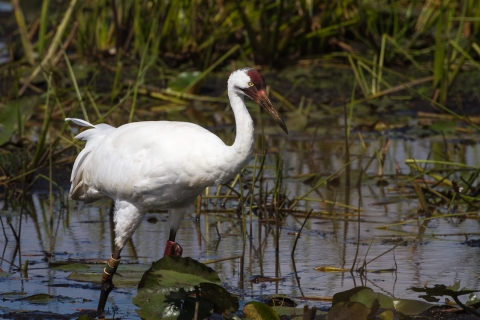This year we celebrate the 50th anniversary of the Endangered Species Act (ESA)—a landmark conservation tool used to protect our nation’s wildlife. To date, the ESA has prevented the extinction of hundreds of iconic American species and protected their habitats and the ecosystems that support them. This year, we reflect on the success stories of the ESA as we consider what the next 50 years of the ESA will look like. In collaboration with many partners, we will usher in a new era of species recovery and bolster species resilience in the face of climate change climate change
Climate change includes both global warming driven by human-induced emissions of greenhouse gases and the resulting large-scale shifts in weather patterns. Though there have been previous periods of climatic change, since the mid-20th century humans have had an unprecedented impact on Earth's climate system and caused change on a global scale.
Learn more about climate change and the loss of biodiversity. The future of the ESA is one in which species are plentiful and resilient enough to no longer require ESA protection. Those threatened and endangered species that do make the list however, will be not only diligently protected but can also be successfully recovered.
The ESA has secured the future of some of the nation’s most iconic and majestic birds: the bald eagle, the California condor, the whooping crane and more. Each of these species is a part of the web of life, with their own unique cultural and biological communities which are essential to our combined well-being. When we invest in conservation, we invest in our own future—ensuring healthy air, land and water and a world rich with biodiversity. As we face great environmental challenges, reflecting on the successes of the ESA can be more inspiring than ever.
There are many remarkable stories of the species that have teetered on the brink of extinction and managed to stave it off, but not many are as amazing as that of the endangered whooping crane. Whooping cranes used to number in the tens of thousands across North America, but following English settlement and westward expansion, there were only an estimated 1,400 left in 1860. Habitat loss and overexploitation caused the bird’s demise and the population hit an all-time low of just 15 birds in 1938.
In response, the whooping crane was listed as threatened in 1967 and listed as endangered by the U.S. Fish and Wildlife Service in 1970 under the Endangered Species Preservation Act of 1966, the ESA’s predecessor. A captive breeding and intensive recovery program were established in order to reintroduce whooping cranes into the wild. Over time, the designation of critical habitat has also protected the nesting habitats and migratory corridors of whooping cranes. The collaborative efforts and effective engagement of various partners—government agencies, Tribes, states, the private sector, NGOs and international governments—has been crucial to the recovery of this species.
One example of a truly collaborative effort to conserve crane habitat is the work that the Rainwater Basin Joint Venture is doing with numerous partners to increase wetland habitats throughout Nebraska. Those 15 surviving whooping cranes all belonged to one flock, called the Aransas-Wood Buffalo population that migrated between Wood Buffalo National Park in Canada and the Aransas National Wildlife Refuge in Texas. This flock, which still migrates through Nebraska every spring and fall, needs suitable habitat where they can stop to rest during their migration. The Rainwater Basin Joint Venture is working with partners at Ducks Unlimited, Natural Resource Conservation Service, and supportive landowners, to restore vital wetlands and create areas for cranes to use during migration.
There are also many examples of on-the-ground restoration projects happening to conserve crane habitat across the landscape. The North American Wetlands Conservation Act (NAWCA) is a multi-million dollar grant program, and has conserved much of the nation’s most important bird habitat, including many grants that have benefited whooping cranes.
For example, the Horicon Coastal Connection project in Wisconsin was awarded NAWCA funds to provide breeding habitat for whooping cranes, which have been documented nesting at Horicon National Wildlife Refuge. However, it’s not just whooping cranes that benefit from this habitat. Protection, restoration, and enhancement of these lands benefit benefit numerous wetland and grassland species, including mallards, American black ducks, northern pintails, wood ducks, ring-necked ducks; American and least bitterns, black-necked stilts, American woodcocks, black terns, and redheads.
And in eastern South Dakota, NAWCA funds are being used to protect, restore, enhance, and establish tens of thousands of acres of globally important wetland and grassland habitats in the Prairie Pothole Region. The Prairie Pothole Region is comprised of abundant and diverse small shallow wetlands interspersed with grasslands, provides vital habitat for migratory birds and wetland-dependent species. Restoring wetlands and enhancing grasslands will provide nesting and migration habitat to an incredibly diverse range of birds including whooping cranes, wood ducks, redheads, canvasbacks, and American wigeons.
After 50 years of federal protection and decades of habitat conservation and protection, it is estimated that more than 500 whooping cranes exist in the wild today. While they remain listed as endangered under the ESA, the recovery from the brink of extinction is significant and one of the ESA’s most notable success stories.
As we celebrate the ESA’s 50th anniversary, we reflect on the conservation wins we have achieved as a result of its original enactment, as well as the future of the ESA—how we can achieve true species recovery and be proactive so that species are plentiful and resilient enough to no longer require ESA protection.






